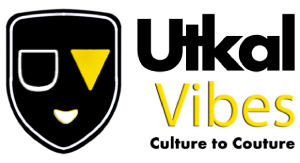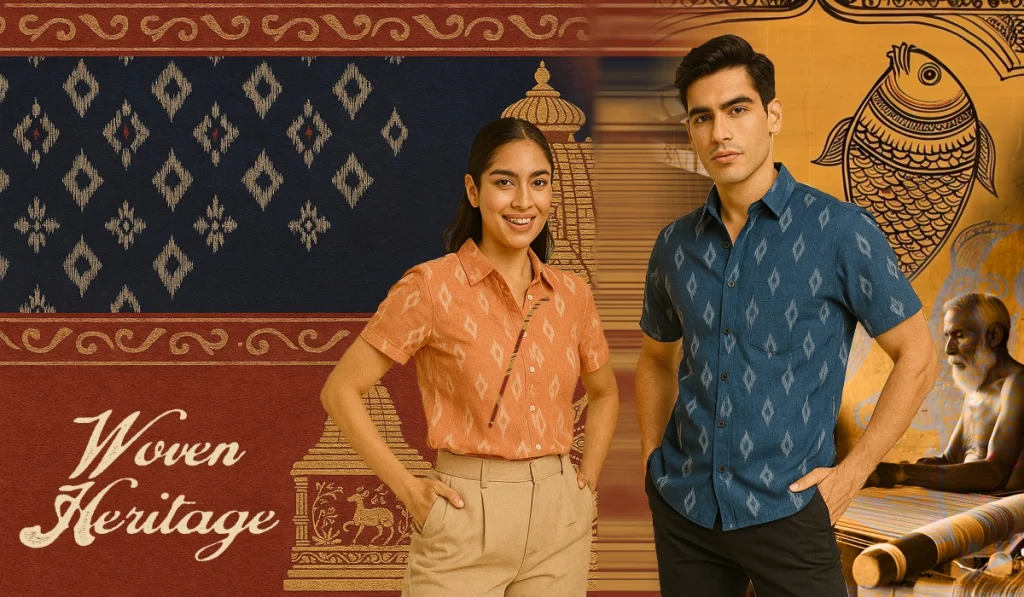Eastern India proudly nurtures a centuries-old craft that blends tradition, identity, and artistry into vibrant fabric, called “Bandha” in the local language. Odisha’s Ikat is far more than a weaving technique it’s a living cultural legacy. It represents Odisha’s rich artistic and cultural heritage. Skilled weavers meticulously craft each piece, using an intricate resist-dyeing technique to create vibrant patterns. These weaves showcase unique craftsmanship, narrate stories through their designs, and preserve deep-rooted traditions. Beyond their artistic brilliance, Odisha’s Ikat fabrics carry profound cultural and spiritual significance, making them an integral part of the region’s identity, also celebrated worldwide for its striking beauty and eco-friendly artistry, Odia Ikat captivates both fashion enthusiasts and cultural connoisseurs.
The Origins of Odia Ikat
Artisans in Odisha have practiced Ikat derived from the Malay-Indonesian word “mengikat” meaning “to tie”. They resist-dye patterns into the yarn before weaving the fabric, a technique that makes every design deeply intentional. Locals call it Bandha, and evidence traces it as far back as the 12th century. The craft thrived under royal patronage and temple culture, particularly in regions like Sambalpur, Bargarh, Sonepur, and Nuapatna.
People wore Ikat garments during rituals, religious festivals, and elite gatherings. The process demanded such skill and patience that the fabric quickly earned reverence. Artisans often drew motifs from Jagannath traditions, nature, and tribal folklore, transforming textiles into symbols of spiritual and cultural expression.
The Bandha Technique: A Weaving of Patience and Precision
Odisha’s Ikat artisans bring patterns to life long before a single thread hits the loom. Unlike printed or embroidered fabrics, they embed the designs directly into the yarn during the dyeing process. Here’s how they do it:
Design Planning: Artisans sketch the desired pattern meticulously onto graph paper.
Tying the Threads: They tightly tie yarn bundles at specific spots to resist dye penetration.
Resist Dyeing: Dipping the yarns into natural and synthetic dyes, often in multiple rounds, artisans build complex colour layers.
Loom Weaving: Finally, they align the dyed threads on the loom with mathematical precision to reveal the finished motif.
This process showcases the artisan’s sharp skill, creative flair, and deep dedication turning each piece into a masterpiece of time, tradition, and heart.
Symbolism and Motifs in Odia Ikat
Odia Ikat artisans thoughtfully weave deeper meanings into every motif. These designs don’t just decorate the fabric, they tell stories.
Temple borders: Artisans echo the grandeur of Odisha’s iconic temples through geometric borders that represent sacred space and devotion.
Fish, elephants, and peacocks: They use these creatures to express themes of prosperity, wisdom, and grace rooted in local folklore.
Geometric patterns: With sharp symmetry and rhythm, these shapes reflect the cosmic balance and spiritual harmony in traditional beliefs.
By drawing inspiration from Jagannath culture, tribal tales, and nature, weavers turn each textile into a vibrant narrative of Odia heritage, ready to be worn, celebrated, and passed down.
Cultural Significance in Odisha
In Odisha, Ikat does more than just wearing a piece of cloth, it expresses identity, emotion, and belonging. Families across the state love wearing Ikat on nearly every special occasions be it weddings, festivals, pujas, or family gatherings. It’s not unusual to see entire households adorned in coordinated Ikat outfits during functions, reflecting unity, pride, and tradition.
Brides drape themselves in Ikat sarees to honour their roots and showcase cultural elegance. During vibrant festivals like Rath Yatra, Raja Parba, and Durga puja, wearing Ikat becomes a way of celebrating heritage through fashion.
For weaver communities like the Bhulia and Meher, weaving Ikat is not just a profession, it’s a sacred inheritance. Families pass down skills through generations, nurturing both the craft and its meaning. These artisans treat their work as a spiritual practice, sustaining not just a textile, but a living, breathing cultural tradition that adapts and endures.
The Revival and Global Reach
Odia Ikat is experiencing a vibrant revival today. As sustainability gains traction, more people are embracing handloom for its eco-friendly, slow-fashion appeal.
Sustainable Fashion Movement: Conscious consumers are actively choosing eco-friendly alternatives. Handwoven Ikat that is free from industrial processes is celebrated as a slow fashion essential that honours craftsmanship and minimizes environmental impact.
Designer Collaborations: Iconic Indian and international designers are reinterpreting Ikat into contemporary forms, from structured shirts to fusion short kurtas, attracting a modern, global audience while preserving cultural integrity.
Digital Platforms and Storytelling: Online marketplaces and social media have empowered weavers and brands to tell their stories, showcase their artistry, and reach customers worldwide, bridging rural looms to urban wardrobes.
Designers in India and abroad are collaborating with artisans, fusing Ikat with modern silhouettes to create fashion that’s both rooted and contemporary. E-commerce platforms and storytelling initiatives are giving weavers a stronger voice and global visibility.
As a result, Odisha’s Ikat now graces global runways and wardrobes, from stylish jackets in Tokyo to flowing dresses in New York. The world isn’t just noticing, it’s celebrating this timeless textile.
Challenges Faced by Artisans
Despite the growing interest in handloom, Ikat weavers face several challenges:
Limited Market Access: Most weavers sell through middlemen, who take a large share of the profits. Direct access to markets remains limited.
Exploitation by Intermediaries: Middlemen often undervalue the work, paying artisans poorly for their time-intensive labour.
Rising Raw Material Costs: Yarn, dyes, and other essentials are becoming increasingly expensive, squeezing the weavers’ already slim margins.
Irregular and Unstable Income: With seasonal demand and inconsistent orders, many artisans struggle to earn a steady livelihood throughout the year.
Generational Disinterest: Younger generations are opting for alternative careers, discouraged by the financial unpredictability and lack of recognition in weaving.
Digital Divide: Many artisans lack access to digital tools, training, and platforms that could help them showcase their work or sell online.
Design Piracy: Machine-made imitations of Ikat patterns flood the market at lower prices, undermining the value of genuine handwoven textiles.
To ensure the survival of this treasured craft, it’s essential to create fair-trade opportunities, promote awareness, and encourage the next generation to see weaving as a viable and respected profession.
The Road Ahead: Preserving Ikat’s Legacy
Odia Ikat’s future rests on our ability to innovate while preserving its roots. As more people across the globe discover and celebrate this beautiful handloom, we must work to maintain its authenticity and uplift its creators.
By investing in design education, sustainable material sourcing, and digital tools, we empower artisans to evolve while honouring tradition. Collaborations between government bodies, ethical brands, and artisan communities are already paving the way for greater visibility and fairer opportunities.
We are not just preserving Ikat, we are propelling it forward. We imagine a world where Odia Ikat thrives in fashion, inspires creativity, and connects generations, all while carrying the same soulful spirit it always has.
Conclusion: Wearing a Legacy
Odisha’s Ikat is more than a beautiful fabric, it’s a legacy, a story, and a celebration of the hands that weave it. Every thread carries generations of knowledge, artistry, and cultural meaning.
In a world chasing trends and speed, choosing Ikat is a return to what matters, mindful making, cultural roots, and timeless elegance. Each time you wear an Ikat piece, you help preserve a story, uplift a community, and pass on a tradition. You become a carrier of culture.
So the next time you drape or don Ikat, remember: you’re not just wearing a textile. You’re wearing generations of soul and skill, wrapped in the warmth of Odisha’s living heritage.
Celebrate craft. Embrace culture. Support handloom.


